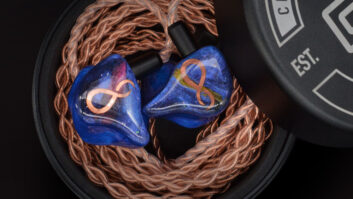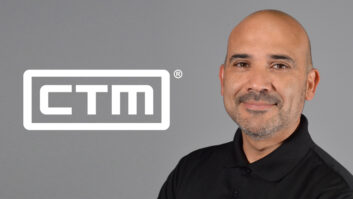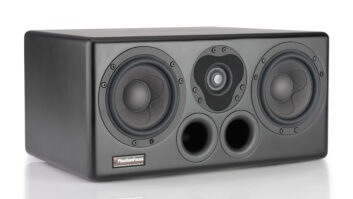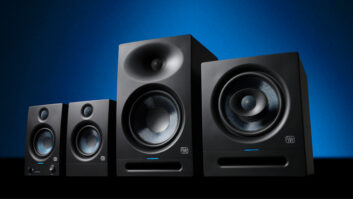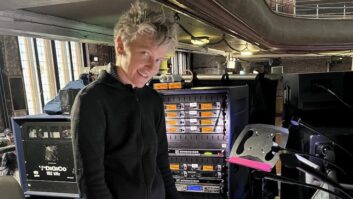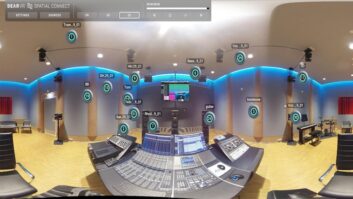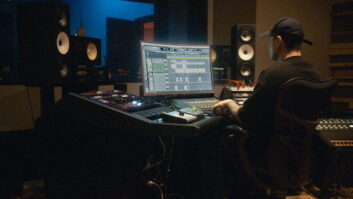Upstairs at the venerable Village Recorder, ensconced in a purpose-built production room, veteran mix engineer Simon Leadley and a triumvirate of composers have been brainstorming nearly non-stop on the music for director Peter Weir’s new film, “Master and Commander: The Far Side of the World.” The movie, based on a best-selling novel by Patrick O’Brian, is set in 1896 and stars Russell Crowe as “Lucky” Jack Aubrey, captain of the H.M.S Surprise, and Paul Bettany (“A Beautiful Mind”) as the ship’s surgeon, Dr. Stephen Maturin. The film follows the ship and its crew as they pursue a French frigate, in a chase that takes them to the far reaches of Tierra del Fuego in South America. It’s a beautiful, intellectual drama, and in true Peter Weir style it’s resplendent with depth and insight into the characters, and what it must have been like to be far from home, adrift in one of these ships, in the surreal world of the late 19th century. Though not an action film by design, the movie is fast-paced and packed with stunning action footage.
Director Peter Weir (“The Truman Show,” “Dead Poets Society”) had very specific ideas about where the film needed music, and what kinds of sonic textures he wanted to hear intertwined with the production’s storms, cannons and other full-spectrum effects. He brought together an unlikely team of composers to realize that vision, including Icehouse singer Iva Davies, American composer Christopher Gordon, and virtuoso violinist Richard Tognetti, creative director for the Australian Chamber Orchestra. Each composer came to the project with decidedly different musical styles and approaches.
“My job is to help to glue these three disparate sources together into a cohesive score,” relates Leadley, whose past credits include “Moulin Rouge,” “Hearts in Atlantis” and “Inspector Gadget 2.” “That involves recording the music, bringing it all together, looking after the mix and all the technical aspects of the session. Each of them has their own way of working. Christopher composes using pen and paper, but he uses Performer and a couple of notation programs as well; Richard was a novice to the technology coming into the project, but he’s been like a sponge, learning all these new technologies; and Iva is an old hand at this stuff.”
Sonically, the landscape is wide and deep, ranging from powerful orchestral pieces to otherworldly synthetic textures and atmospheres. Drums and percussion feature heavily. “We used a percussionist here in L.A., Mike Fisher, who works with Japanese Taiko drums and all sorts of brilliant toys. We went ‘round to his warehouse to pick out drums, and one we chose was an enormous Taiko, 6 feet in diameter, made from a single tree trunk. Try miking that up and making it sound good.”
Synth and percussion tracks were all recorded direct to Leadley’s ProTools HD-1 system, with a second HD-1 system used to capture the orchestra. Tracks were then committed to stems on a third HD-1 system for final mix and lay-up to picture. “The best thing about working this way is that you can always be looking toward the final mix while you’re tracking, rather than bringing hundreds of tracks to the mix. Ultimately I think one makes better decisions when you’re not in a pressure situation like a mixdown. That’s one of the reasons demos always sound better, because you’re working intuitively, not flipping left brain – right brain, agonizing over the mix. In a sense, limiting your choices is actually more empowering.
“I came up through that whole era where we used to spend ten hours hitting drums to get a sound – worse yet, doing it in total isolation, before you’d even heard a note of music. Then along came drum loops, and somebody’d play a loop and you’d say, ‘okay, great groove, we’ll stick that in.’ No one cared that the kick drum sounded crap or whatever; it was all about the vibe, all about the whole thing working together.”
Leadley is a big fan of the Mackie powered monitors, having used both the HR824 and HR624 at his Trackdown Digital Studios in Sydney. For this project, Leadley chose the HR626 monitors, both in stereo and 5.1, with a Mackie HRS120 subwoofer for both configurations. “There’s always so much mystery about speakers, but it all comes down to your either liking them or not. The one thing I find remarkable about the Mackies is that they’re totally non-fatiguing. I used them on Moulin Rouge for up to 17 hours a day. If you’re sitting in front of a set of speakers for that long, the last thing you want is a set of monitors that bark at you. And I can almost say unequivocally, anything we did sounded the same when we took it to the stage. There was never a surprise, never a sense of ‘oh, it sounds totally different than it did in the room,’ which was particularly impressive for Moulin Rouge, where we were dealing with everything from full-on pop music to orchestral textures and sound effects.”
A student of electrical engineering in college, Leadley has a deeper insight than most into the theory of monitor design. “It’s interesting, especially in working with large orchestras and exotic percussion, that we strive to reproduce these huge sounds through transducers a tenth the size. It’s a big task. And it’s always been a compromise – more so with larger monitors. There’s a tremendous amount of compromise in designing an amplifier without knowing what it’s being matched to.
“You can definitely hear the difference with an amp and speaker matched to each other. Particularly in Mackie’s case, where they’ve got their own range of amps as well, they’ve been able to engineer them as a nicely coupled system. I mean, it’s incredible that you’ve got like 150 Watts on the bottom end and another 100 Watts driving the tweeter, but the amp just literally goes right into a coil, so any capacitance is just due to whatever’s in the coil. That makes it a lot easier to design the amp, and do a better job of making it sound good.”
With so much of his film music being done in surround, Leadley notes another advantage to powered monitors. “Setting up speakers in 5.1 used to be a nightmare, setting up all the amps and running through a matrix, sweetening the sub, positioning everything just so. Now it’s easy to just plug the outputs to the back of the desk, focus them as you like, do your quick alignment, and away you go.
“I reckon the advent of powered monitors is something of a quiet revolution. Manufacturers haven’t been shouting it from the rooftops, it’s been more of a subtle evolution. But it’s been one of the single biggest leaps in sound technology, and an enormous change in the way we work and hear things.”

